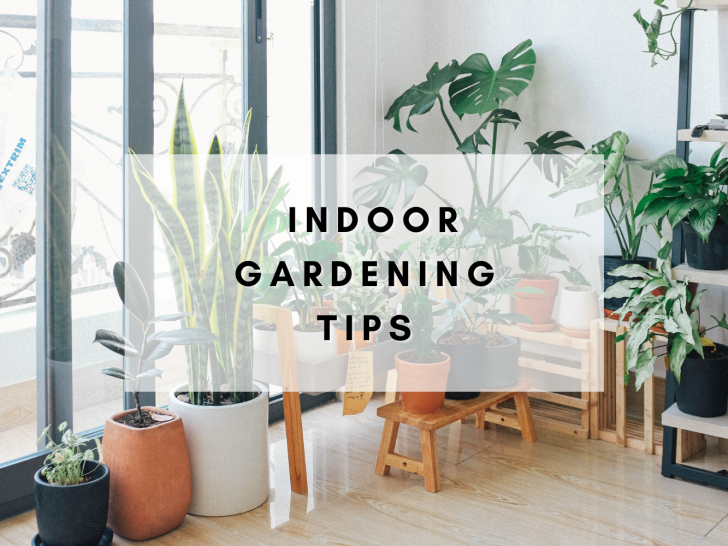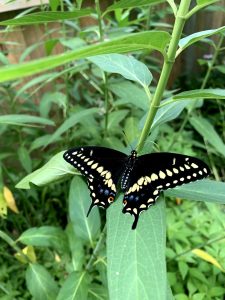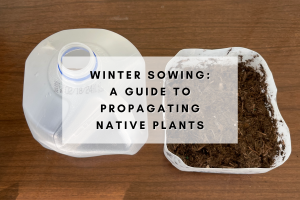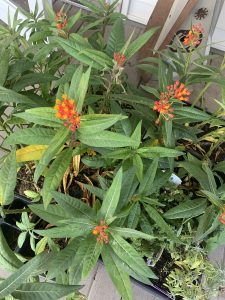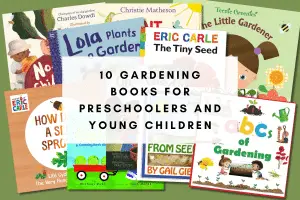In a world dominated by concrete jungles, the allure of bringing nature indoors has never been stronger.
Indoor plants enhance your home decor, improve air quality, and provide a sense of peace in your home.
Indoor gardening serves as a therapeutic escape, allowing us to nurture and witness the beauty of plants within the confines of our homes.
Whether you’re a seasoned gardener or a green thumb novice, here are some simple tips tailored to help you cultivate your own green haven in an indoor space.
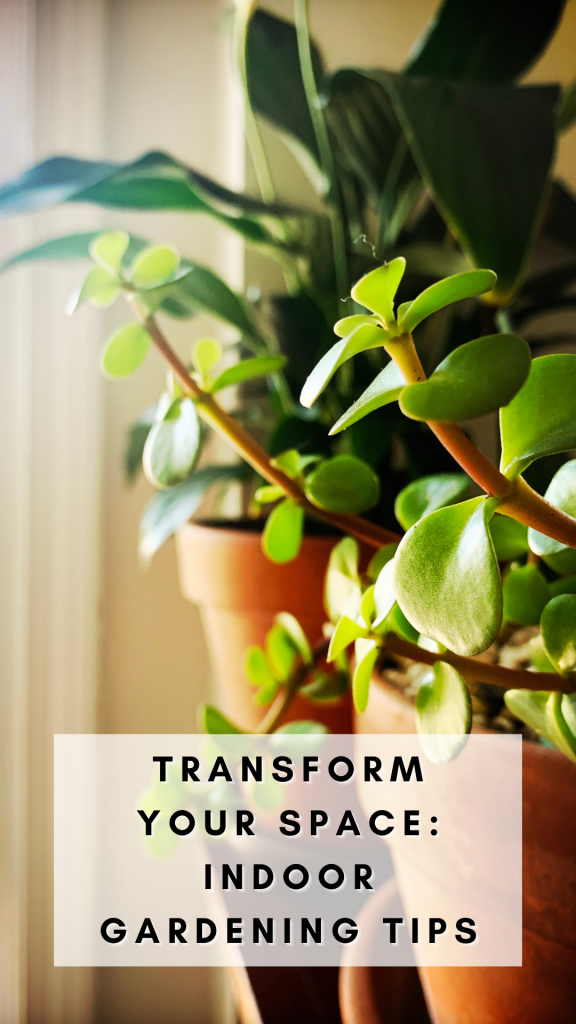
Indoor Gardening Tips
These indoor gardening tips will help you transform your living space into a flourishing oasis of tranquility full of healthy plants.
Learn to grow anything from the most trendy houseplants to your favorite herbs and leafy greens in an indoor vegetable garden.
Choosing the Right Plants
The first step in creating a successful indoor garden is selecting the right plants. Consider the following factors to ensure your chosen green companions thrive.
Light Requirements:
Different plants have varying light needs. Assess the natural light conditions in your home and choose plants that match those requirements.
For low-light areas, consider shade-loving plants like a snake plant, ZZ plants, or pothos that don’t require as much light.
High-light spaces like a south-facing window may make succulents, herbs, or flowering plants a good choice.
You can also use a grow light to improve the growing conditions of spaces with inadequate light.
Space Considerations:
Determine the available space for your indoor garden.
If you have limited space, opt for compact plants like air plants, small herbs, or succulents. Hanging plants can also be a great space saver!
For larger areas, you can explore taller plants or create a multi-level garden using shelves.
Temperature and Humidity:
Take into account the temperature and humidity levels of your home.
Some plants thrive in warmer, more humid conditions, while others prefer cooler, drier climates.
Many houseplants were originally tropical plants, so the addition of a humidifier can be incredibly beneficial for your new plant friends.
Understanding your home’s microclimate helps you choose plants that will flourish in your specific temperature range.
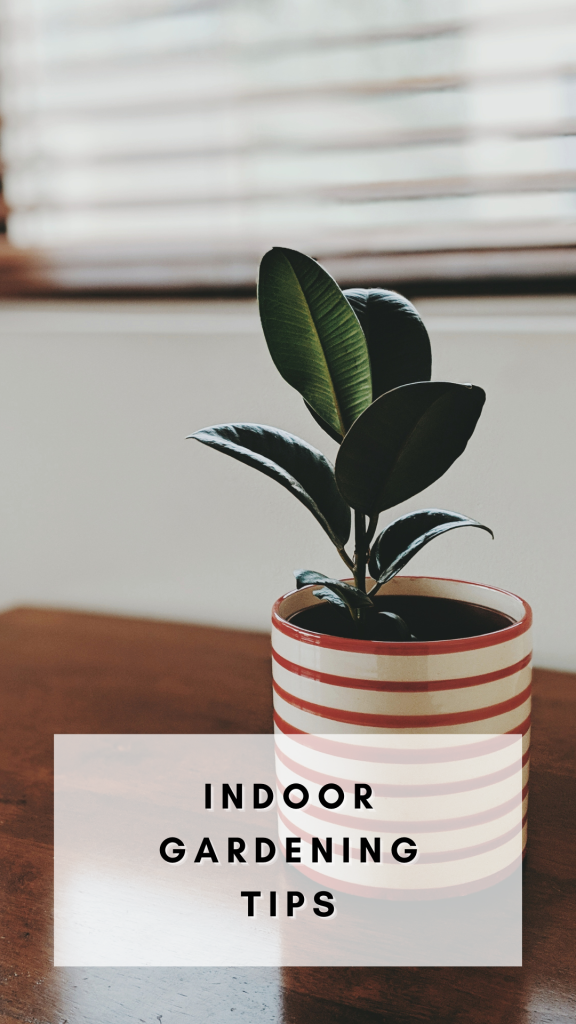
Selecting the Right Containers
Once you’ve chosen your plants, it’s crucial to select the right containers to support their growth and enhance the overall aesthetic of your indoor garden.
Drainage:
Select containers with drainage holes to prevent waterlogged soil, which can lead to root rot.
If you fall in love with a pot that lacks drainage, consider using it as an outer decorative layer for a more functional, well-draining inner pot.
Plant your plant in a well-draining nursery pot and set it inside the decorative pot. Or drill small holes in the bottom to let out excess water.
You can also place plastic drainage trays inside larger plant holders like baskets to get the look you’re going to while caring for your plant’s drainage needs properly.
Size:
Ensure that your chosen containers are appropriately sized for your plants.
A pot that is too small can restrict root growth, while an excessively large pot may lead to overwatering.
Aim for a pot that provides ample room for your plant to grow without drowning it in excess soil.
Typically a pot that’s a couple inches bigger than your plant’s existing pot is perfect.
Material:
Consider the material of your pots based on the water needs of your plants.
Porous materials like terracotta allow for better airflow and water evaporation, suitable for succulents and cacti.
Non-porous materials like plastic pots or glazed ceramic retain moisture better, ideal for moisture-loving plants.
Creating the Ideal Growing Environment
To ensure the right conditions for your indoor garden, pay attention to the indoor environment you’re cultivating.
Light Optimization:
Supplement natural light with artificial lights, especially in spaces with limited sunlight.
If your home is overly shaded or dark, it’s a good idea to invest in full-spectrum grow lights that mimic the sun’s spectrum, providing the necessary wavelengths for photosynthesis.
Adjust the light duration based on the specific needs of your plants.
Air Circulation:
Promote air circulation by strategically placing fans or opening windows when possible.
Good air movement prevents the buildup of pests and diseases, fostering a healthier indoor garden.
Avoid overcrowding plants, allowing them space to breathe and grow.
On the other hand, try not to place plants directly in front of vents as heat and air conditioning may dry out your plants.
Humidity Control:
Maintain optimal humidity levels for your plants, as indoor environments can sometimes be too dry.
Grouping plants together or using a humidifier can help create a more favorable microclimate, especially during the winter months when indoor heating systems can reduce humidity.
You can also spritz humidity-loving plants with a spray bottle occasionally to keep the leaves moist.
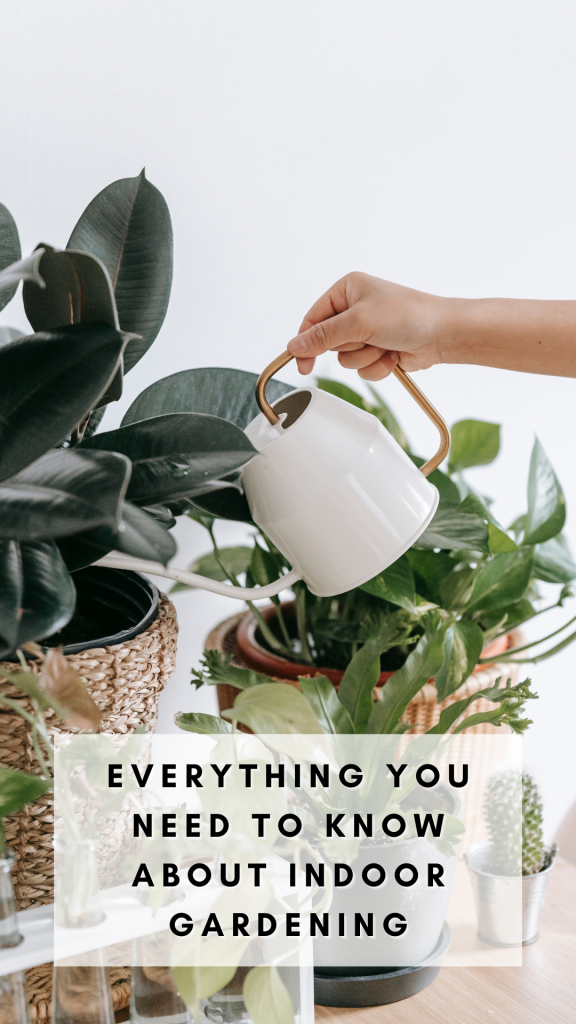
Watering Wisely
Watering is a critical aspect of indoor gardening that requires careful attention to prevent both underwatering and overwatering.
Watering Frequency:
Determine the specific watering needs of each plant, considering factors such as their native environment, size, and current growth stage.
Some plants, like succulents, prefer less water, while tropical plants may need more consistent moisture.
Simply google the name of your plant and read the first 2-3 articles to see how others typically care for that species.
Most plants will need more frequent watering during summer months when daylight hours are longer and can handle reduced watering when the days are shorter.
Soil Moisture:
Even when you’re sticking to your normal watering schedule, you should check your soil moisture before adding more water.
Regularly check the moisture level of the soil by inserting your finger into the top inch. Water your plants only when the soil feels dry to the touch.
Plant roots are often susceptible to root rot and don’t require as much water as you may think.
Invest in a moisture meter for a more accurate assessment, especially if you’re new to gardening.
Watering Techniques:
When watering, do so thoroughly until water drains from the bottom of the pot.
Avoid shallow watering, as it encourages shallow root growth. Be mindful not to let your plants sit in standing water, as this can lead to root rot.
Some people prefer “bottom watering” where you set plants in pots with drainage holes in water and let the soil absorb water from the bottom up.
This can be accomplished by filling a sink or bathtub with a few inches of water and setting plants inside. Alternately, you can also fill the drainage trays with water.
You can also mimic natural rainfalls for tropical plants by occaisionally letting them soak in a shower for a few minutes so their leaves are drenched.
Using the hose outside on a gentle setting to water the leaves well when the weather is nice will accomplish the same thing.
Nutrient Management
Indoor plants rely on the nutrients present in their growing medium, and it’s essential to provide them with the right balance to support healthy growth.
Potting Mix:
Select a high-quality potting mix that suits the specific needs of your plants.
Different species require different soil compositions, so choose mixes tailored to the preferences of your indoor garden inhabitants.
You can find different types of soil at most garden or hardware stores and they are generally labeled for the type of plant they support.
Fertilization:
Feed your plants with a balanced, water-soluble fertilizer during the growing season.
Potted plants will use up all the nutrients in their pot at some point, so it’s crucial to keep replenishing them with the essential nutrients they need.
Follow the recommended dosage on the packaging, as over-fertilizing can harm your plants.
Consider using organic fertilizers for a more sustainable and gentle approach.
Most houseplants can handle fertilizer every 1-2 weeks during the summer months, and monthly during the winter months.
Soil Renewal:
Refresh the soil in your pots periodically by repotting your plants every 2-3 years.
If the roots of your plant show through the top layer of soil, you may need to add more soil sooner and upgrade them to a larger pot if necessary.
This helps replenish nutrients, prevent compacted soil, and gives you the opportunity to inspect the roots for any signs of disease or stress.
Pest Management
Even indoor gardens aren’t immune to pests, so it’s essential to keep a watchful eye and take preventive measures.
Pests that go unnoticed can end up infecting all your houseplants, so it’s crucial that you catch and treat houseplant pests as soon as they become an issue.
Regular Inspections:
Inspect your plants regularly for signs of pests such as spider mites, aphids, or mealybugs. Early detection allows for prompt action, preventing infestations from spreading.
Natural Predators:
Introduce natural predators like ladybugs or predatory mites to control pest populations.
These beneficial insects can help maintain a healthy balance in your indoor garden without the need for chemical interventions.
You can actually easily order these beneficial predators online.
Homemade Remedies:
For minor pest issues, consider using homemade solutions like neem oil or a mixture of mild soap and water.
Diatomaceous earth can help with fungus gnats and other soil-dwelling insects.
These natural remedies are gentle on your plants and the environment while effectively deterring common pests.
Seasonal Considerations
Indoor gardening isn’t a one-size-fits-all endeavor; it requires adjustments based on the changing seasons:
Winter Care:
During the colder months, be mindful of drafty windows and heating systems that can dry out the air.
Grouping plants together, using humidity trays, and adjusting watering frequency can help mitigate winter challenges.
If you’re moving outdoor plants inside for the winter, be sure to treat the soil for any pests that may have found refuge in your pots during their time outside.
Summer Strategies:
In summer, be cautious of excessive heat and direct sunlight.
Move heat-sensitive plants away from windows, provide shade when needed, and increase watering to accommodate higher evaporation rates.
Year-Round Care:
Maintain consistent care throughout the year, adjusting your routine as needed.
Regular observation, coupled with a proactive approach to seasonal changes, is the easiest way to ensure a thriving indoor garden regardless of the weather outside.
Embarking on the journey of indoor gardening is a rewarding endeavor that brings nature’s beauty into your living space.
By carefully selecting plants, containers, and creating an ideal environment, you can cultivate a lush oasis that enhances your well-being.
Implementing these indoor gardening tips ensures that your green haven not only survives but thrives, providing you with a constant source of joy and tranquility.
So, roll up your sleeves, get your hands dirty, and let the world of indoor gardening transform your home into a vibrant sanctuary of greenery.

